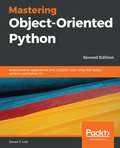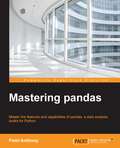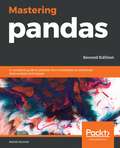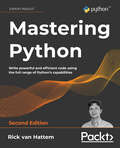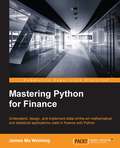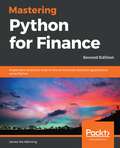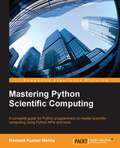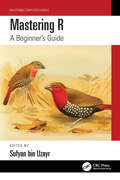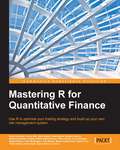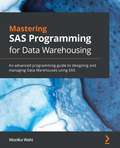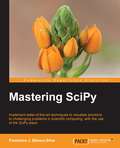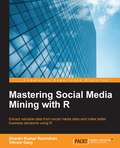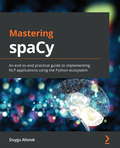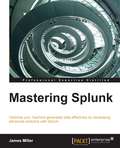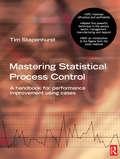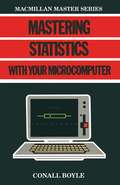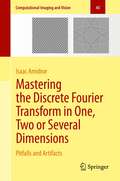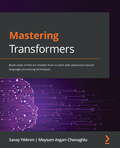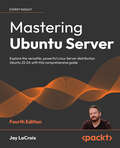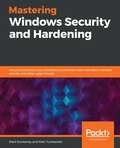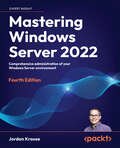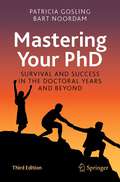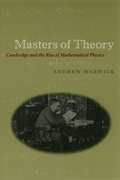- Table View
- List View
Mastering Object-Oriented Python, Second Edition: Build Powerful Applications With Reusable Code Using Oop Design Patterns And Python 3. 7, 2nd Edition
by Steven F. LottMastering Object-Oriented Python, Second Edition, will introduce the advanced features of the Python programming language to create the highest quality Python programs possible. This means exploring design alternatives and determining which design offers the best performance, while still being a good fit with the problem being solved.
Mastering pandas
by Femi AnthonyThis book is intended for Python programmers, mathematicians, and analysts who already have a basic understanding of Python and wish to learn about its data analysis capabilities in depth.
Mastering Pandas, Second Edition: A Complete Guide To Pandas, From Installation To Advanced Data Analysis Techniques, 2nd Edition
by Ashish Kumarpandas is a popular Python library used by data scientists and analysts worldwide to manipulate and analyze their data. This book presents useful techniques and real-world examples on getting the most out of pandas for expert-level data manipulation, analysis and visualization.
Mastering Python: Write Powerful And Efficient Code Using The Full Range Of Pythons Capabilities
by Rick Van HattemThis book delves into the advanced features of the Python programming language and teaches you how they can be utilized to write powerful Python code and packages
Mastering Python for Finance
by James Ma WeimingIf you are an undergraduate or graduate student, a beginner to algorithmic development and research, or a software developer in the financial industry who is interested in using Python for quantitative methods in finance, this is the book for you. It would be helpful to have a bit of familiarity with basic Python usage, but no prior experience is required.
Mastering Python for Finance.: Implement Advanced State-of-the-art Financial Statistical Applications Using Python, 2nd Edition
by James Ma WeimingThis book enables you to develop financial applications by harnessing Python’s strengths in data visualization, interactive analytics, and scientific computing. You will be using popular libraries such as TensorFlow, Keras, sklearn, and so on to extend the functionalities of your financial applications by using smart machine learning techniques.
Mastering Python Scientific Computing
by Hemant Kumar MehtaA complete guide for Python programmers to master scientific computing using Python APIs and tools About This Book • The basics of scientific computing to advanced concepts involving parallel and large scale computation are all covered. • Most of the Python APIs and tools used in scientific computing are discussed in detail • The concepts are discussed with suitable example programs Who This Book Is For If you are a Python programmer and want to get your hands on scientific computing, this book is for you. The book expects you to have had exposure to various concepts of Python programming. What You Will Learn • Fundamentals and components of scientific computing • Scientific computing data management • Performing numerical computing using NumPy and SciPy • Concepts and programming for symbolic computing using SymPy • Using the plotting library matplotlib for data visualization • Data analysis and visualization using Pandas, matplotlib, and IPython • Performing parallel and high performance computing • Real-life case studies and best practices of scientific computing In Detail In today's world, along with theoretical and experimental work, scientific computing has become an important part of scientific disciplines. Numerical calculations, simulations and computer modeling in this day and age form the vast majority of both experimental and theoretical papers. In the scientific method, replication and reproducibility are two important contributing factors. A complete and concrete scientific result should be reproducible and replicable. Python is suitable for scientific computing. A large community of users, plenty of help and documentation, a large collection of scientific libraries and environments, great performance, and good support makes Python a great choice for scientific computing. At present Python is among the top choices for developing scientific workflow and the book targets existing Python developers to master this domain using Python. The main things to learn in the book are the concept of scientific workflow, managing scientific workflow data and performing computation on this data using Python. The book discusses NumPy, SciPy, SymPy, matplotlib, Pandas and IPython with several example programs. Style and approach This book follows a hands-on approach to explain the complex concepts related to scientific computing. It details various APIs using appropriate examples.
Mastering R: A Beginner's Guide (Mastering Computer Science)
by Sufyan Bin UzayrR is a statistical computing and graphics programming language that you can use to clean, analyze, and graph data. It is widely used by researchers from various disciplines to estimate and display results and by teachers of statistics and research methods. This book is a detailed guide for beginners to understand R with an explanation of core statistical and research ideas. One of the powerful characteristics of R is that it is open-source, which means that anyone can access the underlying code used to run the program and add their own code for free. It will always be able to perform the latest statistical analyses as soon as anyone thinks of them. R corrects mistakes quickly and transparently and has put together a community of programming and statistical experts that you can turn to for help. Mastering R: A Beginner’s Guide not only explains how to program but also how to use R for visualization and modeling. The fundamental principles of R explained here are helpful to beginner and intermediate users interested in learning this highly technological and diverse language.
Mastering R: A Beginner's Guide (Mastering Computer Science)
R is a statistical computing and graphics programming language that you can use to clean, analyze, and graph data. It is widely used by researchers from various disciplines to estimate and display results and by teachers of statistics and research methods. This book is a detailed guide for beginners to understand R with an explanation of core statistical and research ideas. One of the powerful characteristics of R is that it is open-source, which means that anyone can access the underlying code used to run the program and add their own code for free. It will always be able to perform the latest statistical analyses as soon as anyone thinks of them. R corrects mistakes quickly and transparently and has put together a community of programming and statistical experts that you can turn to for help. Mastering R: A Beginner’s Guide not only explains how to program but also how to use R for visualization and modeling. The fundamental principles of R explained here are helpful to beginner and intermediate users interested in learning this highly technological and diverse language.
Mastering R for Quantitative Finance
by Edina Berlinger Ferenc Illes Milan BadicsThis book is intended for those who want to learn how to use R's capabilities to build models in quantitative finance at a more advanced level. If you wish to perfectly take up the rhythm of the chapters, you need to be at an intermediate level in quantitative finance and you also need to have a reasonable knowledge of R.
Mastering SAS Programming for Data Warehousing: An advanced programming guide to designing and managing Data Warehouses using SAS
by Monika WahiBuild a strong foundation in SAS data warehousing by understanding data transformation code and policy, data stewardship and management, interconnectivity between SAS and other warehousing products, and print and web reportingKey FeaturesUnderstand how to use SAS macros for standardizing extract, transform, and load (ETL) protocolsDevelop and use data curation files for effective warehouse managementLearn how to develop and manage ETL, policies, and print and web reports that meet user needsBook DescriptionSAS is used for various functions in the development and maintenance of data warehouses, thanks to its reputation of being able to handle 'big data'.This book will help you learn the pros and cons of storing data in SAS. As you progress, you'll understand how to document and design extract-transform-load (ETL) protocols for SAS processes. Later, you'll focus on how the use of SAS arrays and macros can help standardize ETL. The book will also help you examine approaches for serving up data using SAS and explore how connecting SAS to other systems can enhance the data warehouse user's experience.By the end of this data management book, you will have a fundamental understanding of the roles SAS can play in a warehouse environment, and be able to choose wisely when designing your data warehousing processes involving SAS.What you will learnDevelop efficient ways to manage data input/output (I/O) in SASCreate and manage extract, transform, and load (ETL) code in SASStandardize ETL through macro variables, macros, and arraysIdentify data warehouse users and ensure their needs are metDesign crosswalk and other variables to serve analyst needsMaintain data curation files to improve communication and managementUse the output delivery system (ODS) for print and web reportingConnect other products to SAS to optimize storage and reportingWho this book is forThis book is for data architects, managers leading data projects, and programmers or developers using SAS who want to effectively maintain a data lake, data mart, or data warehouse.
Mastering SciPy
by Francisco J. Blanco-SilvaImplement state-of-the-art techniques to visualize solutions to challenging problems in scientific computing, with the use of the SciPy stack About This Book • Master the theory and algorithms behind numerical recipes and how they can be applied to real-world problems • Learn to combine the most appropriate built-in functions from the SciPy stack by understanding the connection between the sources of your problem, volume of data, or computer architecture • A comprehensive coverage of all the mathematical techniques needed to solve the presented topics, with a discussion of the relevant algorithms built in the SciPy stack Who This Book Is For If you are a mathematician, engineer, or computer scientist with a proficiency in Python and familiarity with IPython, this is the book for you. Some basic knowledge of numerical methods in scientific computing would be helpful. What You Will Learn • Master relevant algorithms used in symbolic or numerical mathematics to address approximation, interpolation, differentiation, integration, root-finding, and optimization of scalar or multi-variate functions • Develop different algorithms and strategies to efficiently store and manipulate large matrices of data, in particular to solve systems of linear equations, or compute their eigenvalues/eigenvectors • Understand how to model physical problems with systems of differential equations and distinguish the factors that dictate the strategies to solve them • Perform statistical analysis, hypothesis test design and resolution, or data mining at a higher level, and apply them to real-life problems in the field of data analysis • Gain insights on the power of distances, Delaunay triangulations and Voronoi diagrams for Computational Geometry, and apply them to various engineering problems • Familiarize yourself with different techniques in signal/image processing, including filtering audio, images, or video to extract information, features, or remove components In Detail The SciPy stack is a collection of open source libraries of the powerful scripting language Python, together with its interactive shells. This environment offers a cutting-edge platform for numerical computation, programming, visualization and publishing, and is used by some of the world's leading mathematicians, scientists, and engineers. It works on any operating system that supports Python and is very easy to install, and completely free of charge! It can effectively transform into a data-processing and system-prototyping environment, directly rivalling MATLAB and Octave. This book goes beyond a mere description of the different built-in functions coded in the libraries from the SciPy stack. It presents you with a solid mathematical and computational background to help you identify the right tools for each problem in scientific computing and visualization. You will gain an insight into the best practices with numerical methods depending on the amount or type of data, properties of the mathematical tools employed, or computer architecture, among other factors. The book kicks off with a concise exploration of the basics of numerical linear algebra and graph theory for the treatment of problems that handle large data sets or matrices. In the subsequent chapters, you will delve into the depths of algorithms in symbolic algebra and numerical analysis to address modeling/simulation of various real-world problems with functions (through interpolation, approximation, or creation of systems of differential equations), and extract their representing features (zeros, extrema, integration or differentiation). Lastly, you will move on to advanced concepts of data analysis, image/signal processing, and computational geometry. Style and approach Packed with real-world examples, this book explores the mathematical techniques needed to solve the presented topics, and focuses on the algorithms built in the SciPy stack.
Mastering Social Media Mining with R
by Sharan Kumar Ravindran Vikram GargExtract valuable data from your social media sites and make better business decisions using R About This Book • Explore the social media APIs in R to capture data and tame it • Employ the machine learning capabilities of R to gain optimal business value • A hands-on guide with real-world examples to help you take advantage of the vast opportunities that come with social media data Who This Book Is For If you have basic knowledge of R in terms of its libraries and are aware of different machine learning techniques, this book is for you. Those with experience in data analysis who are interested in mining social media data will find this book useful. What You Will Learn • Access APIs of popular social media sites and extract data • Perform sentiment analysis and identify trending topics • Measure CTR performance for social media campaigns • Implement exploratory data analysis and correlation analysis • Build a logistic regression model to detect spam messages • Construct clusters of pictures using the K-means algorithm and identify popular personalities and destinations • Develop recommendation systems using Collaborative Filtering and the Apriori algorithm In Detail With an increase in the number of users on the web, the content generated has increased substantially, bringing in the need to gain insights into the untapped gold mine that is social media data. For computational statistics, R has an advantage over other languages in providing readily-available data extraction and transformation packages, making it easier to carry out your ETL tasks. Along with this, its data visualization packages help users get a better understanding of the underlying data distributions while its range of "standard" statistical packages simplify analysis of the data. This book will teach you how powerful business cases are solved by applying machine learning techniques on social media data. You will learn about important and recent developments in the field of social media, along with a few advanced topics such as Open Authorization (OAuth). Through practical examples, you will access data from R using APIs of various social media sites such as Twitter, Facebook, Instagram, GitHub, Foursquare, LinkedIn, Blogger, and other networks. We will provide you with detailed explanations on the implementation of various use cases using R programming. With this handy guide, you will be ready to embark on your journey as an independent social media analyst. Style and approach This easy-to-follow guide is packed with hands-on, step-by-step examples that will enable you to convert your real-world social media data into useful, practical information.
Mastering Spacy: An End-to-end Practical Guide To Implementing Nlp Applications Using The Python Ecosystem
by Duygu AltinokAn end-to-end practical guide to implementing NLP applications using the Python ecosystem
Mastering Splunk
by James MillerThis book is for those Splunk developers who want to learn advanced strategies to deal with big data from an enterprise architectural perspective. You need to have good working knowledge of Splunk.
Mastering Statistical Process Control
by Tim StapenhurstMastering Statistical Process Control shows how to understand business or process performance more clearly and more effectively. This practical book is based on a rich and varied selection of case studies from across industry and commerce, including material from the manufacturing, extractive and service sectors. It will enable readers to understand how SPC can be used to maximum effect, and will deliver more effective monitoring, control and improvement in systems, processes and management. The common obstacle to successful use of SPC is getting bogged down with control charts, forgetting that visual representation of data is but a tool and not an end in itself. Mastering SPC demonstrates how statistical tools are applied and used in reality. This is a book that will open up the power of SPC for many: managers, quality professionals, engineers and analysts, as well as students, will welcome the clarity and explanation that it brings to understanding the use and benefit of SPC in a wide range of engineering, production and service situations. Key case studies include using SPC to: · Measure quality and human factors · Monitor process performance accurately over long periods · Develop best-practice benchmarks using control charts · Maximise profitability of fixed assets · Improve customer service and satisfaction
Mastering Statistical Process Control
by Tim StapenhurstMastering Statistical Process Control shows how to understand business or process performance more clearly and more effectively. This practical book is based on a rich and varied selection of case studies from across industry and commerce, including material from the manufacturing, extractive and service sectors. It will enable readers to understand how SPC can be used to maximum effect, and will deliver more effective monitoring, control and improvement in systems, processes and management. The common obstacle to successful use of SPC is getting bogged down with control charts, forgetting that visual representation of data is but a tool and not an end in itself. Mastering SPC demonstrates how statistical tools are applied and used in reality. This is a book that will open up the power of SPC for many: managers, quality professionals, engineers and analysts, as well as students, will welcome the clarity and explanation that it brings to understanding the use and benefit of SPC in a wide range of engineering, production and service situations. Key case studies include using SPC to: · Measure quality and human factors · Monitor process performance accurately over long periods · Develop best-practice benchmarks using control charts · Maximise profitability of fixed assets · Improve customer service and satisfaction
Mastering the Discrete Fourier Transform in One, Two or Several Dimensions: Pitfalls and Artifacts (Computational Imaging and Vision #43)
by Isaac AmidrorThe discrete Fourier transform (DFT) is an extremely useful tool that finds application in many different disciplines. However, its use requires caution. The aim of this book is to explain the DFT and its various artifacts and pitfalls and to show how to avoid these (whenever possible), or at least how to recognize them in order to avoid misinterpretations. This concentrated treatment of the DFT artifacts and pitfalls in a single volume is, indeed, new, and it makes this book a valuable source of information for the widest possible range of DFT users. Special attention is given to the one and two dimensional cases due to their particular importance, but the discussion covers the general multidimensional case, too. The book favours a pictorial, intuitive approach which is supported by mathematics, and the discussion is accompanied by a large number of figures and illustrative examples, some of which are visually attractive and even spectacular. Mastering the Discrete Fourier Transform in One, Two or Several Dimensions is intended for scientists, engineers, students and any readers who wish to widen their knowledge of the DFT and its practical use. This book will also be very useful for ‘naive’ users from various scientific or technical disciplines who have to use the DFT for their respective applications. The prerequisite mathematical background is limited to an elementary familiarity with calculus and with the continuous and discrete Fourier theory.
Mastering Transformers (PDF): Build State-of-the-art Models From Scratch With Advanced Natural Language Processing Techniques
by Savas Yildirim Meysam Asgari-ChenaghluTake a problem-solving approach to learning all about transformers and get up and running in no time by implementing methodologies that will build the future of NLP Key Features Explore quick prototyping with up-to-date Python libraries to create effective solutions to industrial problems Solve advanced NLP problems such as named-entity recognition, information extraction, language generation, and conversational AI Monitor your model's performance with the help of BertViz, exBERT, and TensorBoard Book Description Transformer-based language models have dominated natural language processing (NLP) studies and have now become a new paradigm. With this book, you'll learn how to build various transformer-based NLP applications using the Python Transformers library. The book gives you an introduction to Transformers by showing you how to write your first hello-world program. You'll then learn how a tokenizer works and how to train your own tokenizer. As you advance, you'll explore the architecture of autoencoding models, such as BERT, and autoregressive models, such as GPT. You'll see how to train and fine-tune models for a variety of natural language understanding (NLU) and natural language generation (NLG) problems, including text classification, token classification, and text representation. This book also helps you to learn efficient models for challenging problems, such as long-context NLP tasks with limited computational capacity. You'll also work with multilingual and cross-lingual problems, optimize models by monitoring their performance, and discover how to deconstruct these models for interpretability and explainability. Finally, you'll be able to deploy your transformer models in a production environment. By the end of this NLP book, you'll have learned how to use Transformers to solve advanced NLP problems using advanced models. What you will learn Explore state-of-the-art NLP solutions with the Transformers library Train a language model in any language with any transformer architecture Fine-tune a pre-trained language model to perform several downstream tasks Select the right framework for the training, evaluation, and production of an end-to-end solution Get hands-on experience in using TensorBoard and Weights & Biases Visualize the internal representation of transformer models for interpretability Who this book is for This book is for deep learning researchers, hands-on NLP practitioners, as well as ML/NLP educators and students who want to start their journey with Transformers. Beginner-level machine learning knowledge and a good command of Python will help you get the best out of this book.
Mastering Ubuntu Server: Explore The Versatile, Powerful Linux Server Distribution Ubuntu 22.04 With This Comprehensive Guide
by Jay LaCroixMastering Windows Security and Hardening: Secure and Protect your Windows Environment from Intruders, Malware Attacks, and other Cyber Threats
by Mark Dunkerley Matt TumbarelloAre you looking for effective ways to protect Windows-based systems from being compromised by unauthorized users? Mastering Windows Security and Hardening is a detailed guide that helps you gain expertise when implementing efficient security measures and creating robust defense solutions. We will begin with an introduction to Windows security fundamentals, baselining, and the importance of building a baseline for an organization. As you advance, you will learn how to effectively secure and harden your Windows-based system, protect identities, and even manage access. In the concluding chapters, the book will take you through testing, monitoring, and security operations. In addition to this, you'll be equipped with the tools you need to ensure compliance and continuous monitoring through security operations. By the end of this book, you'll have developed a full understanding of the processes and tools involved in securing and hardening your Windows environment.
Mastering Windows Server 2022: Comprehensive Administration Of Your Windows Server Environment
by Jordan KrauseMastering Your PhD: Survival and Success in the Doctoral Years and Beyond
by Patricia Gosling Bart NoordamThis bestselling book guides PhD students through their graduate years and beyond. Filled with practical advice on getting started, communicating with your supervisor, staying the course, and planning for the future, this book is an indispensable guide for graduate students who need that extra bit of help getting started and making it through. Who should read this book? Any student currently in, or curious about, a PhD programme, be it in the physical and life sciences, engineering, computer science, math, medicine, or the humanities — this book tackles the obstacles and hurdles that almost all PhD students face during their doctoral training. Whether you’re at the very beginning of your research, close to the end, or just feeling frustrated and stuck at any point in between…it’s never too early — or too late — to focus on your success! This third edition contains a variety of new material, including additional chapters and advice on how to make the most of remote learning, collaboration, and communication tools, as well as updated material on your next career step once you have your coveted doctoral degree in hand. Some of the material in the third edition appeared as part of a monthly column on the ScienceCareers website.
Masters of Theory: Cambridge and the Rise of Mathematical Physics
by Andrew WarwickWinner of the the Susan Elizabeth Abrams Prize in History of Science. When Isaac Newton published the Principia three centuries ago, only a few scholars were capable of understanding his conceptually demanding work. Yet this esoteric knowledge quickly became accessible in the nineteenth and early twentieth centuries when Britain produced many leading mathematical physicists. In this book, Andrew Warwick shows how the education of these "masters of theory" led them to transform our understanding of everything from the flight of a boomerang to the structure of the universe. Warwick focuses on Cambridge University, where many of the best physicists trained. He begins by tracing the dramatic changes in undergraduate education there since the eighteenth century, especially the gradual emergence of the private tutor as the most important teacher of mathematics. Next he explores the material culture of mathematics instruction, showing how the humble pen and paper so crucial to this study transformed everything from classroom teaching to final examinations. Balancing their intense intellectual work with strenuous physical exercise, the students themselves—known as the "Wranglers"—helped foster the competitive spirit that drove them in the classroom and informed the Victorian ideal of a manly student. Finally, by investigating several historical "cases," such as the reception of Albert Einstein's special and general theories of relativity, Warwick shows how the production, transmission, and reception of new knowledge was profoundly shaped by the skills taught to Cambridge undergraduates. Drawing on a wealth of new archival evidence and illustrations, Masters of Theory examines the origins of a cultural tradition within which the complex world of theoretical physics was made commonplace.
